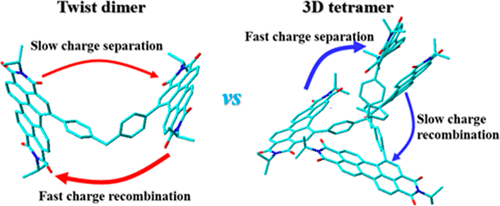当前位置:
X-MOL 学术
›
J. Phys. Chem. Lett.
›
论文详情
Our official English website, www.x-mol.net, welcomes your feedback! (Note: you will need to create a separate account there.)
Excited-State Symmetry-Breaking Charge Separation Dynamics in Multibranched Perylene Diimide Molecules
The Journal of Physical Chemistry Letters ( IF 5.7 ) Pub Date : 2020-11-24 , DOI: 10.1021/acs.jpclett.0c03210 Jie Kong 1, 2 , Wei Zhang 1, 2 , Gang Li 3 , Dayujia Huo 4 , Yuanyuan Guo 1, 2 , Xinmiao Niu 1, 2 , Yan Wan 4 , Bo Tang 3 , Andong Xia 1, 5
The Journal of Physical Chemistry Letters ( IF 5.7 ) Pub Date : 2020-11-24 , DOI: 10.1021/acs.jpclett.0c03210 Jie Kong 1, 2 , Wei Zhang 1, 2 , Gang Li 3 , Dayujia Huo 4 , Yuanyuan Guo 1, 2 , Xinmiao Niu 1, 2 , Yan Wan 4 , Bo Tang 3 , Andong Xia 1, 5
Affiliation

|
As one of the most promising nonfullerene acceptors for organic photovoltaics, perylene diimide (PDI)-based multibranched molecules with twisted or three-dimensional (3D) geometric structures have been developed, which effectively increase the power conversion efficiency (PCE) of organic solar cells. Understanding the structure–property relationships in multichromophoric molecular architectures at molecular and ultrafast time levels is a crucial step in establishing new design principles in organic electronic materials. For this, photodriven excited-state symmetry-breaking charge separation (SB-CS) of PDI-based multichromophoric acceptors has been proposed to improve the PCE by reducing the self-aggregation of the planar PDI monomer. Herein, we investigated the intramolecular excited-state SB-CS and charge recombination (CR) dynamics of two symmetric phenyl-methane-based PDI derivatives, a twist dimer PM-PDI2 (phenyl-methane-based PDI dimer) and a 3D configuration tetramer PM-PDI4 (phenyl-methane-based PDI tetramer), in different solvents using ultrafast femtosecond transient absorption (fs-TA) spectroscopy and quantum chemical calculations. The quantum chemical calculations and steady-state spectra show that the two PDI derivatives undergo conformational changes upon excitation, leading to their emission states that have the characteristics of partial charge-transfer (CT) exciton in all solvents. Based on the evolution of the fs-TA data, it is observed that the evolution from the CT state to SB-CS state is disfavored in a weak polar solvent, whereas clear SB-CS spectroscopic signatures of cationic and anionic PDI are observed in polar solvents. Faster CS and slower CR processes of PM-PDI4 are observed in comparison to those of PM-PDI2. The crowded space in the 3D structure shortens the distance between the branches, leading to a stronger electronic coupling at the lowest excited state and a larger negative Gibbs free energy change of PM-PDI4 relative to that of PM-PDI2, which benefits the charge separation among PDI units in PM-PDI4. Besides, the 3D structure of PM-PDI4 also restricts rotation to a surface crossing region between the excited state and ground state, thus inhibiting nonradiative CR process and increasing the CS state lifetime. Our results suggest that the kinetics of CS and CR processes are strongly related to the molecular geometric structure, and the excited-state symmetry breaking in the 3D structure acceptor has superior photogenerated charge and photovoltaic properties from the perspective of ultrafast dynamics.
中文翻译:

多支Per二酰亚胺分子的激发态对称断裂电荷分离动力学
作为有机光伏最有希望的非富勒烯受体之一,已开发出具有扭曲或三维(3D)几何结构的per二酰亚胺(PDI)基多支分子,可有效提高有机太阳能电池的功率转换效率(PCE) 。在分子和超快时间水平上了解多发色分子结构中的结构-性质关系是在有机电子材料中建立新设计原理的关键步骤。为此,已经提出了基于PDI的多发色受体的光驱动激发态对称破坏电荷分离(SB-CS),以通过减少平面PDI单体的自聚集来改善PCE。在这里2(基于苯基甲烷的PDI二聚体)和3D配置四聚体PM-PDI 4(基于苯基甲烷的PDI四聚体),在不同的溶剂中使用超快速飞秒瞬态吸收(fs-TA)光谱和量子化学计算。量子化学计算和稳态光谱表明,两种PDI衍生物在激发时发生构象变化,导致它们的发射态在所有溶剂中均具有部分电荷转移(CT)激子的特征。根据fs-TA数据的演变,发现在弱极性溶剂中,从CT态到SB-CS态的演化是不利的,而在极性下,阳离子和阴离子PDI的SB-CS光谱特征清晰溶剂。PM-PDI的CS速度更快和CR过程更慢与PM-PDI 2相比,观察到图4。3D结构中的拥挤空间缩短了分支之间的距离,从而导致在最低激发态下的电子耦合更强,相对于PM-PDI 2而言,PM-PDI 4的负Gibbs自由能变化更大。PM-PDI中PDI单元之间的电荷分离4。此外,PM-PDI 4的3D结构还限制了旋转到激发态和基态之间的表面交叉区域,从而抑制了非辐射CR过程并延长了CS态寿命。我们的结果表明,CS和CR过程的动力学与分子的几何结构密切相关,并且从超快动力学的角度来看,在3D结构受体中激发态对称性的断裂具有优异的光生电荷和光伏性质。
更新日期:2020-12-17
中文翻译:

多支Per二酰亚胺分子的激发态对称断裂电荷分离动力学
作为有机光伏最有希望的非富勒烯受体之一,已开发出具有扭曲或三维(3D)几何结构的per二酰亚胺(PDI)基多支分子,可有效提高有机太阳能电池的功率转换效率(PCE) 。在分子和超快时间水平上了解多发色分子结构中的结构-性质关系是在有机电子材料中建立新设计原理的关键步骤。为此,已经提出了基于PDI的多发色受体的光驱动激发态对称破坏电荷分离(SB-CS),以通过减少平面PDI单体的自聚集来改善PCE。在这里2(基于苯基甲烷的PDI二聚体)和3D配置四聚体PM-PDI 4(基于苯基甲烷的PDI四聚体),在不同的溶剂中使用超快速飞秒瞬态吸收(fs-TA)光谱和量子化学计算。量子化学计算和稳态光谱表明,两种PDI衍生物在激发时发生构象变化,导致它们的发射态在所有溶剂中均具有部分电荷转移(CT)激子的特征。根据fs-TA数据的演变,发现在弱极性溶剂中,从CT态到SB-CS态的演化是不利的,而在极性下,阳离子和阴离子PDI的SB-CS光谱特征清晰溶剂。PM-PDI的CS速度更快和CR过程更慢与PM-PDI 2相比,观察到图4。3D结构中的拥挤空间缩短了分支之间的距离,从而导致在最低激发态下的电子耦合更强,相对于PM-PDI 2而言,PM-PDI 4的负Gibbs自由能变化更大。PM-PDI中PDI单元之间的电荷分离4。此外,PM-PDI 4的3D结构还限制了旋转到激发态和基态之间的表面交叉区域,从而抑制了非辐射CR过程并延长了CS态寿命。我们的结果表明,CS和CR过程的动力学与分子的几何结构密切相关,并且从超快动力学的角度来看,在3D结构受体中激发态对称性的断裂具有优异的光生电荷和光伏性质。



























 京公网安备 11010802027423号
京公网安备 11010802027423号